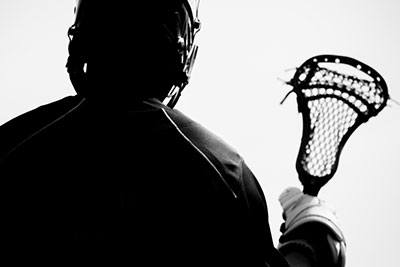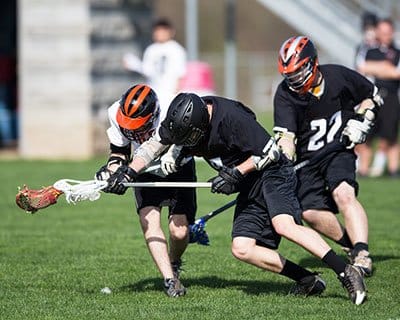The lacrosse warding penalty has become an increasingly important part of the game.
This penalty can have a huge impact on the outcome of a match and coaches must be aware of when it should be called and how they can best utilize it to their advantage.
In this guide, we will analyze the effects that enforcing the lacrosse warding penalty has on games and discuss strategies for using it effectively. We will also look at examples from professional matches to illustrate their implications in competitive play.
With this information, players and coaches can better understand how to take full advantage of this rule change for success on and off the field.
More...
Take away key points:
What is the lacrosse warding penalty?
Warding in lacrosse is a penalty that occurs when a player in possession of the ball uses their free hand or arm to physically hold or an defensive player or their lacrosse stick.
This type of action is dangerous and can lead to serious injury as well as give the team with possession of the ball an unfair advantage. Warding also prevents players from changing direction on the field or accessing open space, which reduces their ability to score.
As such, it is important for players and coaches to understand what types of contact constitute warding so they can avoid committing this penalty and prevent injury on the field.
How are lacrosse warding laws regulated?
According to the National Federation of High School (NFHS) rulebook, a player in possession of the ball shall not use their free hand or arm to push or control the direction of the movement of their crosse or body.
In 2019, however, an amendment was made that prohibits a lacrosse player with two hands on their crosse from using their free hand or free arm to push the body of the player applying the check.
The new rule on warding differs from the old rule, which allowed players in possession of the ball to move or control the movements of opponents while they had two hands on their sticks.
Now, contact with an opponent's body is deemed a ward even if the attacker has two hands on their lacrosse stick; however, contact with just the opponent's stick is still not considered warding. This updated rule was put in place to prevent serious injury and to ensure fair play for all teams.

Does warding have an exception in lacrosse?
Lacrosse community is a sport where warding technical fouls can be given for contact that does not meet the legal criteria. As such, players are encouraged to use their free arms when anticipating contact from a defender.
This means that the player in possession of the ball may be allowed to defend their lacrosse stick with their free arm or hand, provided they do not extend it outwardly. However, if any pushing or blocking occurs as a result of using the free arm, an official warding will be issued.
Stiff arming is illegal in lacrosse, as it is form of warding and could lead to dangerous physical contact.
In lacrosse, stiff arm are not permitted as it is considered a form of warding. This means that when a player in possession of the ball anticipates contact from a defender, they cannot extend their free arm outward in order to stop or gain leverage during a check. If they do, they will be penalized with a technical foul and will have to serve thirty seconds in the penalty box.
Examples of warding in lacrosse
Here are some examples of how it can be used:
- Bracing: when a player brings their arm up and out to prepare for contact with an opponent.
- Blocking: when a player uses their free hand or free arm to stop or slow down an opposing player's stick or body.
- Holding: when a player grabs the stick, arms, or body of another player in order to keep them away from the ball carrier.
- Pressurizing: pushing off with your hands on an opponent's chest or shoulder area in order to gain leverage over them and maintain control of the ball.
What is the punishment for warding penalties?
Warding off rule is considered a technical foul in the game of lacrosse and if penalized for it, a player must face the consequences.
The most common consequence of forwarding is that the offensive player will be given thirty seconds in the penalty box, and their team will be at a disadvantage with one less player on the field.
As warding is an action that can potentially lead to serious injury, any violations are taken seriously by game officials in order to ensure safe play.
Stiff arm vs. warding: Are they the same?
In lacrosse, there is some confusion between stiff arms and warding. While other sports may permit the use of stiff arms, in lacrosse, it is considered a form of warding and is illegal.
However, what does it mean "to stiff arm?" in lacrosse?
Lacrosse has strict rules relating to any conspicuous arm extension, using a free hand or arm to shove or hold an opponent, and intentional contact with the of the other player. Body checks can also be considered as unnecessary roughness which can be followed by a penalty and personal fouls.
Stiff arming is also a common mistake with lacrosse players who transition from other contact sports.
If a referee notices that one of these infractions of stiff arming is happening, they will blow the whistle or throw the yellow flag onto the field. As a result, it is rare for lacrosse players at higher levels of lacrosse to risk attempting a stiff arm.
Stiff arms are a form of warding in lacrosse that is not allowed and can result in a penalty. Stiff arms are when a player commits the possession of the ball and extends their arm outwardly in anticipation of contact from an opponent to gain leverage or stop a check. This gesture is considered illegal as it is deemed to be unfair and potentially dangerous. If caught, the offensive player will receive a technical foul and must serve thirty seconds in the penalty box for stiff arm.
How to gain possession of the ball legally?
Gaining possession of the ball is key to success in lacrosse. It is important to know how to do it without committing fouls or penalties.
There are two primary ways to get the ball legally and with proper technique: pick-ups and interceptions.
Pick-ups
Pick-ups involve scooping up a ball on the ground, while interceptions involve catching a pass that has been thrown by an opposing player. This is done in order to gain control of the ball and set up an attack or defensive play.
It is important to be aware of your surroundings when trying to pick up a loose ball, as you can commit fouls if you make contact with another player before picking it up.
Additionally, if two players attempt to pick up the same loose ball, the opposing team that called the check will take possession.
Interceptions

Interceptions in lacrosse involve catching a thrown pass from an opposing player. They are usually a result of good defensive positioning and reading the play accurately, as well as anticipation of where the ball is likely to be delivered.
To intercept a pass, players must first position themselves between their opponent and the intended target. When they see that the ball has been thrown, they can attempt to catch it and gain possession of the ball for their team.
Conclusion
The lacrosse warding penalty is an important rule change that can have a major impact on the outcome of a match.
It’s important for coaches and players to understand when it should be called, how it works, and how to utilize it to their advantage best.
By understanding the effects of warding, they can take full advantage of this rule change and increase their chances of success on and off the field.
